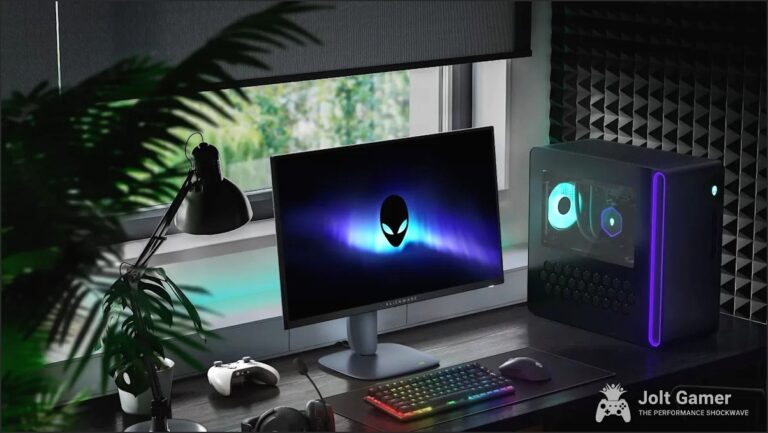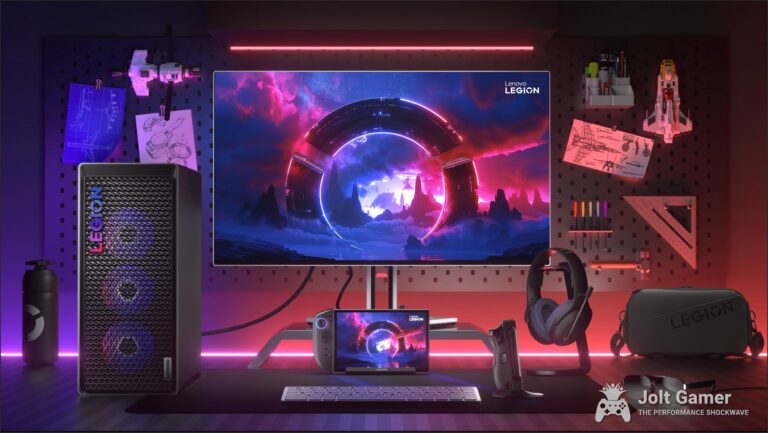The Super-Ultrawide Dream: Samsung’s Odyssey OLED G9 Arrives
The gaming monitor landscape is a battleground of innovation, and few releases command attention quite like a new flagship from Samsung’s esteemed Odyssey line. The Odyssey OLED G9, available in G95SC and G93SC variants, is far more than just another ultrawide display; it’s a 49-inch QD-OLED behemoth. Unveiled with significant fanfare at CES 2023 and quickly hitting retail channels, this monitor promises unparalleled immersion and blistering speed, aiming to fundamentally redefine the expectations of both serious gamers and demanding power users. But does this cutting-edge display truly live up to the considerable hype? More critically, can it successfully navigate the inherent challenges of OLED technology, such as burn-in concerns, and meet the complex productivity demands of its target audience, particularly regarding seamless multi-source integration? JoltGamer is diving deep to deliver the definitive analysis.
Key Takeaways
- 49-inch Dual QHD (5120×1440) QD-OLED display with 1800R curve offers stunning visuals and immersion.
- Blazing fast 240Hz refresh rate and 0.03ms GtG response time, plus FreeSync Premium Pro, for elite gaming performance.
- Integrated Smart Hub (G95SC) transforms it into a full entertainment center with cloud gaming and streaming.
- Productivity features like PiP/PbP are powerful, but community feedback highlights concerns about KVM/source switching reliability on older G9 models.
- OLED burn-in remains a key worry for mixed-use scenarios, despite Samsung’s prevention features.
- Premium pricing positions it as a high-end investment, with variants (G95SC vs. G93SC) offering different feature sets.
QD-OLED: A Visual Feast for Gamers
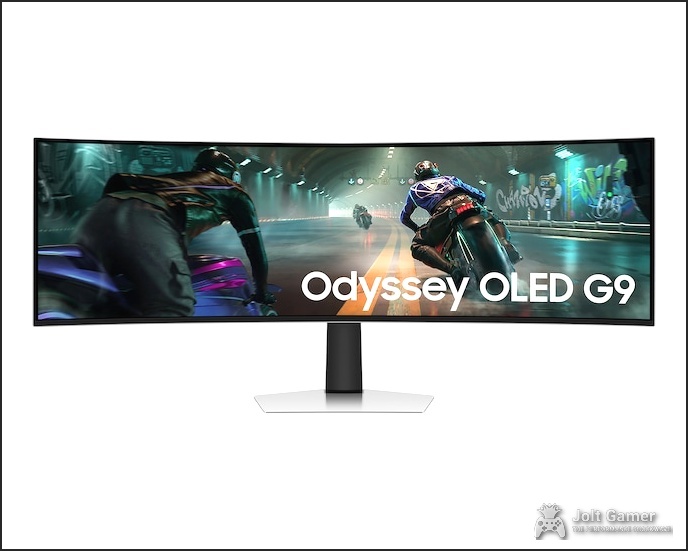
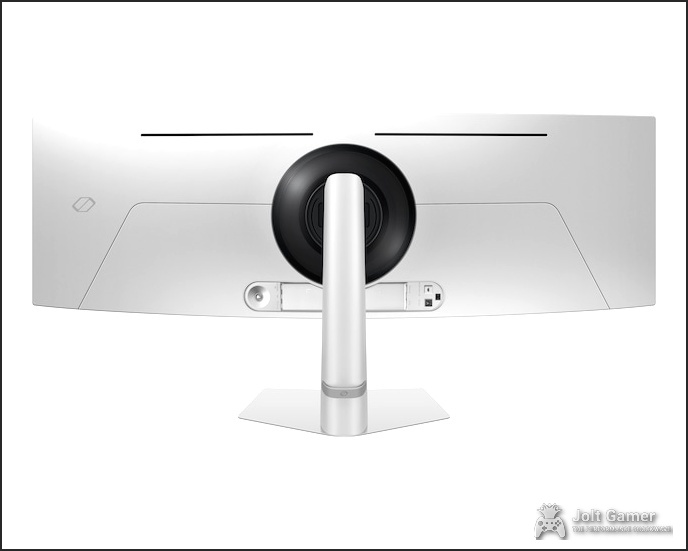
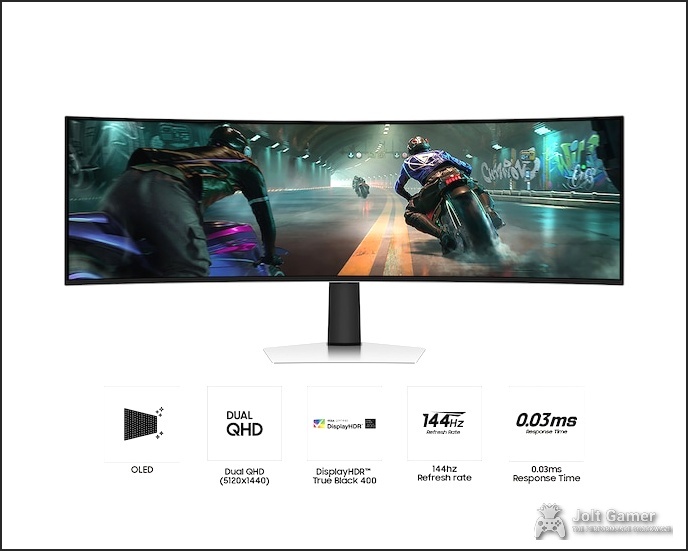
At the very core of the Odyssey OLED G9’s visual prowess is Samsung’s Quantum Dot OLED (QD-OLED) panel. This is not simply another iteration of OLED; it represents a sophisticated hybrid technology that synergistically combines the perfect self-emissive properties of OLED pixels with the enhanced color purity and brightness capabilities of quantum dots. The empirical result is a display that renders true, inky blacks, boasts a near-infinite 1,000,000:1 static contrast ratio, and produces an exceptionally wide color spectrum with vibrant, demonstrably accurate colors, covering 100% of the DCI-P3 gamut. Crucially, unlike traditional WOLED panels that often rely on color filters, QD-OLED pixels are directly self-illuminating and precisely enhanced by quantum dots, which translates to superior color volume and contrast performance even at higher brightness levels, with virtually no light leakage to compromise dark scenes. The physical experience is equally impactful: the 1800R curvature meticulously wraps the expansive 49-inch, 32:9 aspect ratio screen around the user’s peripheral vision, forging an incredibly immersive environment that effectively feels like two perfectly merged 27-inch QHD monitors. This design choice is fundamental to its “super-ultrawide” designation and its promise of unparalleled immersion.
Samsung Odyssey OLED G9 (G95SC/G93SC) Key Specifications
| Display Size | 49-inch |
|---|---|
| Panel Type | QD-OLED |
| Resolution | Dual QHD (5120 x 1440) |
| Aspect Ratio | 32:9 |
| Curvature | 1800R |
| Refresh Rate | 240Hz |
| Response Time (GtG) | 0.03ms |
| Contrast Ratio | 1,000,000:1 (Static) |
| HDR Support | VESA DisplayHDR True Black 400 |
| Brightness (Typical/HDR Peak) | 250 nits / 400 nits |
| Color Gamut | 100% DCI-P3 |
| Adaptive Sync | AMD FreeSync Premium Pro, G-SYNC Compatible |
| Connectivity | HDMI 2.1, Micro HDMI 2.1, DisplayPort 1.4, USB Hub |
| Speakers | Built-in Stereo (2x 5W) |
| Smart Features (G95SC only) | Samsung Gaming Hub, Smart TV Apps (Netflix, Prime Video), Wi-Fi 5, Bluetooth 5.2, Voice Assistants (Alexa, Bixby) |
| Burn-in Prevention | Thermal Modulation System, Logo/Taskbar Detection, Screen Saver, Pixel Refresh, Pixel Shift |
Unrivaled Speed: 240Hz, 0.03ms, and FreeSync Premium Pro
For the discerning competitive gamer, raw speed and responsiveness are non-negotiable metrics, and the Odyssey OLED G9 delivers an abundance of both. Its blistering 240Hz refresh rate is a critical factor, ensuring incredibly fluid motion that translates directly into faster target acquisition and superior tracking precision. This high refresh rate is meticulously paired with an ultra-low 0.03ms Grey-to-Grey (GtG) response time, a combination that renders pixel transitions virtually instantaneous, effectively eliminating ghosting and motion blur that can plague lesser displays. Furthermore, the inclusion of AMD FreeSync Premium Pro, alongside confirmed G-SYNC compatibility, guarantees a tear-free, stutter-free gaming experience. This adaptive sync technology dynamically synchronizes the monitor’s refresh rate with the GPU’s frame output, even in the most graphically demanding titles. Underlying these core performance metrics, the Neo Quantum Processor Pro, leveraging advanced deep learning algorithms, actively enhances visuals through intelligent AI upscaling, continuously optimizing brightness and contrast in real-time for a consistently brilliant image.
Hypothetical In-Game FPS: Odyssey OLED G9 (5120×1440)
Loading chart data…
The Odyssey OLED G9’s super-ultrawide gaming experience puts it in a class of its own, raising the bar for OLED monitors. With the launch of our Odyssey OLED gaming monitors, Samsung aims to offer gamers new levels of immersion with unrivaled picture quality and innovative gaming features only Samsung can deliver.
The Dual-Purpose Dilemma: Work, Play, and Smart Integration
While undeniably engineered with the hardcore gamer as its primary focus, the Odyssey OLED G9 is also equipped with a robust suite of features designed for enhanced productivity and comprehensive entertainment. The Picture-by-Picture (PbP) and Picture-in-Picture (PiP) functionalities are exceptionally powerful here, allowing users to seamlessly connect two disparate input sources and display them concurrently at their native resolutions. This capability fundamentally transforms the monitor into a highly effective, single-display replacement for a traditional multi-monitor workstation. The G95SC variant further extends this versatility by incorporating a full Smart TV experience, driven by its Neo Quantum Pro processor and Tizen OS. This includes integrated Wi-Fi 5, Bluetooth 5.2, capable built-in stereo speakers, and direct access to popular streaming applications such as Netflix and Prime Video. Critically, the Samsung Gaming Hub offers direct, PC-free access to leading cloud gaming services like Xbox Cloud Gaming and NVIDIA GeForce NOW, positioning the G95SC as a genuine standalone gaming and entertainment hub. However, this ambitious integration of multiple sources and smart functionalities inherently introduces its own set of operational challenges, particularly for users needing to fluidly transition between demanding work and immersive play.
Community Concern: KVM & Source Switching Reliability
The JoltGamer community, particularly those who have invested in previous Samsung G9 iterations, has voiced consistent frustration regarding the reliability and speed of KVM (Keyboard, Video, Mouse) and source switching. While the new Odyssey OLED G9 offers robust connectivity, including HDMI 2.1, DisplayPort 1.4, and a comprehensive USB hub (with Type-C upstream/downstream for the G95SC), alongside Auto Source Switch Plus, the expectation for seamless, instantaneous transitions between a work-focused PC and a gaming rig remains exceptionally high. For a monitor positioned at this premium segment and explicitly marketed for its dual-purpose versatility, consistent and flawless performance in these areas is absolutely critical to prevent users from needing cumbersome external workarounds and to avoid widespread dissatisfaction. Prospective buyers are strongly advised to meticulously track long-term user reviews concerning the stability and responsiveness of these specific productivity features before committing.
Another prominent and empirically valid concern for any OLED monitor, particularly when it’s intended for a mixed-use scenario encompassing both intensive gaming and prolonged productivity tasks, is the inherent risk of burn-in from static UI elements. Samsung has proactively addressed this by integrating a comprehensive suite of “Panel Care” features into the Odyssey OLED G9, specifically designed to mitigate this risk. These include a sophisticated Thermal Modulation System that dynamically adjusts brightness based on predicted surface temperature, Logo and Taskbar Detection which intelligently dims static images (though this particular feature is noted as not being active in PC mode), a Screen Saver that engages after 10 minutes of inactivity, and the essential Pixel Refresh and Pixel Shift functions. While these measures are clearly intended to extend the panel’s operational longevity and reliability, the community’s persistent “Worry” regarding OLED burn-in, especially for users who will have static productivity interfaces on screen for hours daily, remains a significant, data-driven factor influencing adoption decisions.
Odyssey OLED G9: The Good & The Considerations
Pros
- Stunning QD-OLED visuals with true blacks and vibrant colors.
- Exceptional gaming performance: 240Hz, 0.03ms, FreeSync Premium Pro.
- Immersive 49-inch, 1800R ultrawide experience (equivalent to dual QHD).
- G95SC offers full Smart TV and Samsung Gaming Hub integration.
- Robust burn-in prevention features.
- Premium, slim metal design with ergonomic stand.
Considerations
- High premium price point.
- Community concerns about KVM/source switching reliability (historical G9 models).
- Lingering user worry about OLED burn-in for mixed productivity use.
- G93SC variant lacks smart features and remote control.
- Modest SDR brightness compared to some alternatives.
G95SC vs. G93SC: Which Odyssey OLED is Right for You?
Samsung Odyssey OLED G9 Variants & Key Competitors
| Feature | Odyssey OLED G95SC | Odyssey OLED G93SC | Odyssey Neo G9 (57-inch) | LG UltraGear OLED (45-inch) |
|---|---|---|---|---|
| Panel Type | QD-OLED | QD-OLED | Quantum Mini LED | WOLED |
| Size & Resolution | 49″ DQHD (5120×1440) | 49″ DQHD (5120×1440) | 57″ Dual UHD (7680×2160) | 45″ WQHD (3440×1440) |
| Refresh Rate | 240Hz | 240Hz | 240Hz | 240Hz |
| Response Time (GtG) | 0.03ms | 0.03ms | 1ms | 0.03ms |
| Smart TV/Gaming Hub | Yes | No | No | No |
| Price (Launch/Typical) | $2,199.99 USD | $1,272.00 – $1,349.00 USD | $2,500.00 USD | $1,699.99 USD |
The Samsung Odyssey OLED G9 is primarily available in two distinct configurations: the G95SC and the G93SC. While both models share the identical, visually stunning 49-inch QD-OLED panel and the core, high-performance gaming specifications—including the 240Hz refresh rate and 0.03ms response time—the G93SC represents a more streamlined, focused offering. This variant intentionally omits the Smart TV processor, integrated applications, and the included remote control that are central to the G95SC’s feature set. Consequently, the G93SC emerges as a pure gaming monitor, significantly more affordable and appealing to users who already have dedicated streaming devices or simply do not require integrated smart functionalities. When positioned against other formidable ultrawide displays, the G9 OLED distinguishes itself through its QD-OLED panel and its true Dual QHD (5120×1440) resolution, offering a pixel density and screen real estate advantage over many competitors. For those seeking an even grander scale, the 57-inch Odyssey Neo G9 presents an even larger, higher-resolution experience, leveraging Quantum Mini LED technology. This alternative effectively eliminates burn-in risk and boasts higher peak brightness, though it comes with a substantially higher price tag and a fundamentally different visual characteristic. LG’s 45-inch UltraGear OLED is also a strong competitor, delivering a comparable OLED experience but on a smaller screen with a WQHD (3440×1440) resolution, typically at a more accessible price point. Ultimately, the optimal choice hinges on your specific budget, your prioritization of integrated smart features, and your willingness to invest in the absolute bleeding edge of ultrawide display technology.
The JoltGamer Verdict
The JoltGamer Verdict
The Samsung Odyssey OLED G9 (G95SC/G93SC) is a groundbreaking monitor that delivers an unparalleled super-ultrawide gaming experience. Its QD-OLED panel produces stunning visuals with true blacks and vibrant colors, while the 240Hz refresh rate and 0.03ms response time offer a competitive edge that few displays can match. The G95SC’s integrated Smart Hub and Gaming Hub push the boundaries of what a monitor can be, transforming it into a standalone entertainment powerhouse. However, it’s not without its considerations. The premium price tag is a significant investment, and despite Samsung’s burn-in prevention efforts, the community’s ‘Worry’ about OLED longevity for mixed-use scenarios is valid. Furthermore, the ‘Frustration’ with KVM and source switching on previous G9 models means potential buyers should proceed with cautious optimism regarding these productivity features. If you’re a dedicated gamer seeking the ultimate immersive experience and have the budget, the Odyssey OLED G9 is a truly exceptional piece of hardware. For those prioritizing productivity or extreme caution regarding burn-in, careful consideration of its limitations and alternatives is advised. Ultimately, it’s a technological marvel that sets a new bar, but one that demands an informed commitment.
Purchase Information: Samsung Odyssey OLED G9 Gaming Monitor
Product: Samsung Odyssey OLED G9 Gaming Monitor (G95SC/G93SC)
Price Range: $1,272.00 – $2,199.99 USD (depending on model and promotions)
Release Date: June 2023 (G95SC), Q3 2023 (G93SC)
Where to Buy:
Notes: Prices and availability are subject to change. Check retailers for current offers, including potential discounts or gift card promotions.
Your Questions Answered: Odyssey OLED G9 FAQ
Is OLED burn-in still a major concern with the Odyssey OLED G9?
While Samsung has meticulously integrated several advanced burn-in prevention features—including Thermal Modulation, Logo and Taskbar Detection, and Pixel Refresh/Shift functions—the fundamental risk of burn-in remains an inherent characteristic of OLED technology. This risk is particularly elevated with static UI elements displayed over extended periods. For users who intend to engage in heavy mixed-use, combining intensive productivity tasks with static interfaces alongside dynamic gaming, this remains a valid and empirically recognized concern. We strongly advise activating and utilizing all available panel care features and actively varying content to minimize this risk. Furthermore, always scrutinize the specific terms of any warranty, as burn-in coverage can vary.
How reliable are the KVM and source switching features?
Community feedback, particularly from owners of previous Samsung G9 models, unequivocally indicates a consistent “Frustration” with the reliability and speed of KVM and source switching functionalities. While the Odyssey OLED G9 incorporates Auto Source Switch Plus and offers robust modern connectivity, its real-world performance for truly seamless, instantaneous transitions between, for example, a work laptop and a dedicated gaming desktop, is a critical metric that requires long-term user validation. We recommend managing expectations and, for mission-critical workflows, considering robust external KVM solutions as a proactive measure.
What’s the difference between the G95SC and G93SC models?
Both the G95SC and G93SC models share the identical, high-performance 49-inch DQHD QD-OLED panel and core gaming specifications (240Hz refresh rate, 0.03ms response time). The key differentiator lies in the G95SC’s inclusion of Samsung’s full Smart Hub, Gaming Hub, Wi-Fi, Bluetooth, integrated stereo speakers, and an included remote control, offering a comprehensive Smart TV experience. The G93SC, conversely, omits these smart features, positioning it as a more focused, and consequently more affordable, pure gaming monitor.
Is the Odyssey OLED G9 good for console gaming?
Absolutely. The Odyssey OLED G9 is exceptionally well-suited for console gaming, thanks to its HDMI 2.1 connectivity. This enables support for 4K 120Hz gaming on current-generation consoles like the PlayStation 5 and Xbox Series X. While the monitor’s native resolution is Dual QHD (5120×1440), consoles will typically output at 4K, which the monitor can effectively handle, or 1440p, which will be scaled. It is important to note that the ultrawide aspect ratio may result in black bars on the sides for many console games that do not natively support it, but the OLED panel’s superior visual quality will still deliver an outstanding and immersive experience.
How does the Odyssey OLED G9 compare to the Odyssey Neo G9?
The core distinction lies in panel technology and scale. The Odyssey OLED G9 leverages QD-OLED technology, delivering unparalleled contrast, true blacks, and rapid response times. In contrast, the 57-inch Odyssey Neo G9 utilizes Quantum Mini LED technology, which boasts significantly higher peak brightness and completely eliminates the risk of burn-in. The Neo G9 also offers a substantially higher Dual UHD (7680×2160) resolution and supports the cutting-edge DisplayPort 2.1. While the OLED G9 prioritizes pixel-perfect contrast and instantaneous response, the Neo G9 offers sheer size, brightness, and raw resolution, albeit with a different panel technology and a higher price point.



